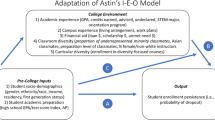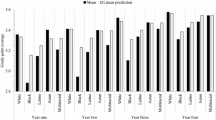Abstract
This paper delves into a facet of socioeconomic diversity relatively unaddressed in the literature: student reports of cross–class interaction (“reported CCI”). Previous research has found that student interaction across social class is a significant predictor of cross–racial interaction, but it is unknown whether the actual socioeconomic heterogeneity of a student body is significantly related to reported CCI. We use hierarchical linear modeling to identify predictors of reported CCI in the 2003 Freshman/2007 College Student Survey from the UCLA Higher Education Research Institute. In the final model, students who attended more socioeconomically diverse institutions and more racially diverse institutions reported higher levels of CCI. Findings suggest that reported CCI is linked to the actual socioeconomic heterogeneity of a student body. Measures of racial diversity (percent of students of color and diversity engagement), both at the institutional and student level, also predicted reported CCI. Thus, reported CCI is likely influenced by the racial diversity of a student body and other aspects of the campus racial climate, in addition to socioeconomic diversity. Implications for campus climate, diversity, and equity research are discussed.
Similar content being viewed by others

Notes
We recognize that much of the research actually examines “racial/ethnic diversity,” but for the sake of simplicity, we refer to “racial diversity” in the remainder of the paper.
We tested various iterations of the SSD variable, with differing “peaks” at 40, 50, 60, 70, and 80 %. We then correlated each of these different inverted-U shaped variables with CCI to examine which one was associated with the most CCI. The correlations showed that institutions with 50 % of students receiving aid were associated with the most frequent student reports of interactions across class.
References
Allen, W. R., Jayakumar, U. M., Griffin, K. A., Korn, W. S., & Hurtado, S. (2005). Black undergraduates from Bakke to Grutter. Los Angeles: UCLA Higher Education Research Institute.
Allison, P. D. (2002). Missing data. Thousand Oaks: Sage Publications.
Allport, G. W. (1954). The Nature of Prejudice. Reading: Addison-Wesley.
Aries, E. (2008). Race and class matters at an elite college. Philadelphia: Temple University Press.
Bailey, T., Jenkins, D., & Leinbach, T. (2005). What we know about community college low-income and minority student outcomes: Descriptive statistics from national surveys. New York: Columbia University, Teachers College, Community College Research Center.
Bastedo, M. & Jaquette, O. (2009). Institutional stratification and the fit hypothesis: Longitudinal shifts in student access. Paper presented at the annual conference of the Association for the Study of Higher Education. Vancouver, Canada.
Bowman, N. A. (2010). Can first-year college students accurately report their learning and development? American Educational Research Journal, 47, 466–496.
Bowman, N. A. (2011). Promoting participation in a diverse democracy: A meta-analysis of college diversity experiences and civic engagement. Review of Educational Research, 81, 29–68.
Carnevale, A. P., & Rose, S. J. (2003). SES status, race/ethnicity, and selective college admissions. New York: The Century Foundation.
Chang, M. J. (1999). Does racial diversity matter?: The educational impact of a racially diverse undergraduate population. Journal of College Student Development, 40(4), 283–301.
Chang, M. J., Astin, A. W., & Kim, D. (2004). Cross–racial interaction among undergraduates: Some causes and consequences. Research in Higher Education, 45, 527–551.
Chang, M. J., Park, J. J., Lin, M. H., Poon, O. A., Nakanishi, D. (2007). Beyond myths: The growth and diversity of Asian American college freshmen, 1971–2005. Los Angeles: UCLA Higher Education Research Institute.
Chang, M. J., & Yamamura, E. (2006). Quantitative approaches to measuring student body diversity: Some examples and thoughts. In W. Allen, M. Bonous-Hammarth, & R. T. Teranishi (Eds.), Higher education in a global society: Achieving diversity, equity and excellence (pp. 369–386). Oxford: Elsevier.
Cohen, J., Cohen, P., West, S. G., & Aiken, L. S. (2003). Applied multiple regression/correlation analysis for the behavioral sciences (3rd ed.). Mahwah: Lawrence Erlbaum.
Cole, D., & Ahmadi, S. (2010). Reconsidering campus diversity: An examination of Muslim students’ experiences. Journal of Higher Education, 81(2), 121–139.
Deil-Amen, R., & Tevis, T. L. (2010). Circumscribed agency: The relevance of standardized college entrance exams for low SES high school students. The Review of Higher Education, 33, 140–170.
Espenshade, T. J., & Radford, A. W. (2009). No longer separate, not yet equal: Race and class in elite college admission and campus life. Princeton: Princeton University Press.
Gurin, P., Dey, E., Gurin, G., & Hurtado, S. (2004). The educational value of diversity. In P. Gurin, J. Lehman, & E. Lewis (Eds.), Defending diversity: Affirmative action at the University of Michigan (pp. 97–188). Ann Arbor: University of Michigan Press.
Hall, W. D., Cabrera, A. F., & Milem, J. F. (2011). A Tale of two groups: Differences between minority students and non-minority students in their predispositions to and engagement with diverse peers at a predominantly White institution. Research in Higher Education, 52, 420–439.
Hurtado, S., Saenz, V. B., Santos, J. L., & Cabrera, N. (2008). Advancing in higher education: A portrait of Latina/o college freshmen at four-year institutions, 1975–2006. Los Angeles: UCLA Higher Education Research Institute.
Inside Higher Education (2011). Clashes of money and values: A survey of admissions directors. Inside Higher Education. http://www.insidehighered.com/news/survey/admissions2011. Accessed 1 Oct 2011.
Jayakumar, U. M. (2008). Can higher education meet the needs of an increasingly diverse and global society? Campus diversity and cross-cultural workforce competencies. Harvard Educational Review, 78(4), 615–651.
Kahlenberg, R. (2010). Rewarding strivers: Helping low-income students succeed in college. Washington, DC: Century Foundation.
Locks, A. M., Hurtado, S., Bowman, N. A., & Oseguera, L. (2008). Extending notions of campus climate and diversity to students’ transitions to college. Review of Higher Education, 31(3), 257–285.
McDonough, P. M. (1997). Choosing colleges: How social class and schools structure opportunity. Albany: SUNY.
McDonough, P. M., & Calderone, S. (2006). Perceptual differences between college counselors and low-income families about college costs and financial aid. American Behavioral Scientist, 49(12), 1703–1718.
Norton, M. I., & Ariely, D. (2011). Building a better America: One wealth quintile at a time. Perspectives on Psychological Science, 6(1), 9–12.
Ostrove, J. M., & Long, S. M. (2007). Social class and belonging: Implications for college adjustment. The Review of Higher Education, 30(4), 363–389.
Park, J. J. (2012). When race and religion collide: The effect of religion on interracial friendship in college. Journal of Diversity in Higher Education, 5(1), 8–21.
Park, J. J. (2013). When diversity drops: Race, religion, and affirmative action in higher education. New Brunswick: Rutgers University Press.
Park, J. J., Denson, N., & Bowman, N. (2013). Does socioeconomic diversity make a difference? Examining the effects of racial and socioeconomic diversity on the campus climate for diversity. American Educational Research Journal.
Park, J. J., & Eagan, M. K. (2011). Who goes early? A multi-level analysis of enrollment via early action and early decision admissions. Teachers College Record, 113(11), 2345–2373.
Perna, L. W. (2006). Studying college choice: A proposed conceptual model. In J. C. Smart (Ed.), Higher education: Handbook of theory and research (Vol. XXI, pp. 99–157). Cambridge: Springer.
Raudenbush, S. W., & Bryk, A. S. (2002). Hierarchical linear models: Applications and data analysis methods (2nd ed.). Thousand Oaks: Sage.
Sáenz, V. (2010). Breaking the segregation cycle: examining students’ precollege racial environments and college diversity experiences. The Review of Higher Education, 34(1), 1–37.
Sax, L. J., Lindholm, J. A., Astin, A. W., Korn, W. S., Saenz, V. B., & Mahoney, K. M. (2003). The American freshman: National norms for fall 2003. Los Angeles: Higher Education Research Institute, UCLA.
Spinosa, H., Sharkness, J., Pryor, J. H., & Liu, A. (2008). Findings from the 2007 administration of the College Senior Survey (CSS): National aggregates. Los Angeles: Higher Education Research Institute, UCLA.
St. John, E. (2003). Refinancing the college dream. Baltimore: Johns Hopkins University Press.
Stearns, E., Buchmann, C., & Bonneau, K. (2009). Interracial friendships in the transition to college: Do birds of a feather flock together once they leave the nest? Sociology of Education, 82, 173–195.
Supiano, B., & Fuller, A. (2011). Elite colleges fail to gain more students on Pell Grants. Chronicle of Higher Education. http://chronicle.com/article/Pell-Grant-Recipients-Are/126892/.
The Journal of Blacks in Higher Education (2009). Disappointing progress in enrollments of low-income students at America’s most selective colleges and universities. The Journal of Blacks in Higher Education. http://www.jbhe.com/features/61_lowincome.html. Accessed 1 Oct 2011.
Walpole, M. (2008). Emerging from the pipeline: African American students, socioeconomic status, and college experiences and outcomes. Research in Higher Education, 49(3), 237–255.
Acknowledgments
This study was supported by the Australian Research Council’s Discovery Projects funding scheme [DP1094417].
Author information
Authors and Affiliations
Corresponding author
Appendix
Appendix
Rights and permissions
About this article
Cite this article
Park, J.J., Denson, N. When Race and Class Both Matter: The Relationship between Socioeconomic Diversity, Racial Diversity, and Student Reports of Cross–Class Interaction. Res High Educ 54, 725–745 (2013). https://doi.org/10.1007/s11162-013-9289-4
Received:
Published:
Issue Date:
DOI: https://doi.org/10.1007/s11162-013-9289-4



